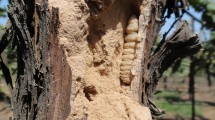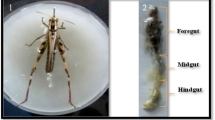Abstract
Neurozerra conferta Walker is the principal Lepidopteran pest found associating with the Aquilaria trees in fragrant agarwood formations. Agarwood obtained through the involvement of this insect is reportedly superior in quality, with fine fragrance, high in demand and with higher market value. The role of this insect in conferring agarwood formation is obscure. The infestation by N. conferta essentially opens a gateway for microbial infection, which is the fundamental basis for agarwood formation. The bacterial diversity is also reportedly found to be higher in insect infested agarwood. For the first time, a culture dependent approach was made to isolate bacteria from the gut of N. conferta. A total of 10 bacteria were isolated that belong to families Enterobacteriaceae, Yersiniaceae and Pseudomonadaceae. 16S rRNA sequencing revealed the gut bacteria diversity composed of Enterobacter roggenkampii, E. cloacae, E. asburiae, Serratia marcescens, S. nematodiphila, Klebsiella oxytoca, K. variicola, Pseudomonas aeruginosa, Raoultella ornithinolytica, and Citrobacter freundii. A screening for enzyme activity revealed, S. marcescens with the highest cellulase and xylanase activity, while K. variicola showed highest lipase activity. Being closely associated with gut of the larvae of N. conferta these isolates with important enzyme potentials can be involved in the formation of agarwood resin which can lead to newer insights on agarwood aroma which is still not clearly understood.





Similar content being viewed by others
Abbreviations
- PBS:
-
Phosphate-buffered saline
- ANOVA:
-
Analysis of Variance
- BSA:
-
Bovine serum albumin
- CMC:
-
Carboxy Methyl Cellulose
- CRD:
-
Completely Randomised Design
- CTAB:
-
Cetyltrimethyl ammonium bromide
- DNS:
-
3,5-Dinitrosalicylic acid
- EI:
-
Enzymatic Index
- EMBL:
-
European Molecular Biology Laboratory
- ICAR:
-
Indian Council of Agricultural Research
- LBA:
-
Luria Bertani Agar
- MEGA:
-
Molecular Evolutionary Genetics Analysis
- NCBI:
-
National Centre for Biotechnology Information
- OD:
-
Optical Density
- PCR:
-
Polymerase Chain Reactions
- pNPP:
-
p-nitrophenol palmitate
- RPM:
-
Revolutions Per Minute
- TBA:
-
Tributyrin agar
- WASP:
-
Web Agri Stat Package
References
Abuldahab FF, Abd-ElAziz MF, El-Sayed YA, Abdallah MS, Mahmoud SH (2022) Infestation of Apis mellifera workers and larvae with Varroa destructor affects gut bacterial diversity. J Entomol Acarol Res 54(2). https://doi.org/10.4081/jear.2022.10316
Acevedo FE, Rivera-Vega LJ, Chung SH, Ray S, Felton GW (2015) Cues from chewing insects—the intersection of DAMPs, HAMPs, MAMPs and effectors. Curr Opin Plant Biol 26:80–86. https://doi.org/10.1016/j.pbi.2015.05.029
Acevedo FE, Peiffer M, Tan CW, Stanley BA, Stanley A, Wang J, Jones AG, Hoover K, Rosa C, Luthe D, Felton G (2017) Fall armyworm-associated gut bacteria modulate plant defense responses. Mol Plant-Microbe Interact 30(2):127–137. https://doi.org/10.1094/MPMI-11-16-0240-R
Behar A, Yuval B, Jurkevitch E (2005) Enterobacteria-mediated nitrogen fixation in natural populations of the fruit fly Ceratitis capitata. Mol Ecol 14(9):2637–2643. https://doi.org/10.1111/j.1365-294X.2005.02615.x
Bhore SJ, Preveena J, Kandasamy KI (2013) Isolation and identification of bacterial endophytes from pharmaceutical agarwood-producing Aquilaria species. Pharmacogn Res 5(2):134. https://doi.org/10.4103/2F0974-8490.110545
Borthakur ND, Borah RK, Dutta BK, Jayaraj RSC (2021) Neurozerra conferta Walker. (beehole borer) on Aquilaria malaccensis Lamk. in Assam. Indian For 147(3): 276-280. https://doi.org/10.36808/if/2F2021/2Fv147i3/2F153696
Chhipa H, Kaushik N (2017) Fungal and bacterial diversity isolated from Aquilaria malaccensis tree and soil, induces agarospirol formation within 3 months after artificial infection. Front Microbiol 8:1286. https://doi.org/10.3389/fmicb.2017.01286
Chung JP, Chen KH (2018) Developing an in vitro quasi-symbiotic culture system of Aquilaria malaccensis with potentially beneficial microbes on agarwood resinous formation. Plant Cell Tissue Organ Cult (PCTOC) 133(2):193–202. https://doi.org/10.1007/s11240-017-1372-7
Chung SH, Rosa C, Scully ED, Peiffer M, Tooker JF, Hoover K, Luthe DS, Felton GW (2013) Herbivore exploits orally secreted bacteria to suppress plant defenses. Proc Natl Acad Sci 110(39):15728–15733. https://doi.org/10.1073/pnas.1308867110
Dehghanikhah F, Shakarami J, Asoodeh A (2021) Isolation and identification of lignin-degrading bacteria with laccase activity from the gut of the leopard moth, Zeuzera pyrina (Lepidoptera: Cossidae). J Crop Prot 10(1):41–49
Dillon RJ, Dillon VM (2004) The gut bacteria of insects: nonpathogenic interactions. Annu Rev Entomol 49(1):71–92. https://doi.org/10.1146/annurev.ento.49.061802.123416
dos Santos Melo-Nascimento AO, Mota Moitinho Sant’ Anna B, Goncalves CC, Santos G, Noronha E, Parachin N, de Abreu Roque MR, Bruce T (2015) Complete genome reveals genetic repertoire and potential metabolic strategies involved in lignin degradation by environmental ligninolytic Klebsiella variicola P1CD1. PloS one 15(12):e0243739. https://doi.org/10.1371/journal.pone.0243739
Duran-Bedolla J, Garza-Ramos U, Rodríguez-Medina N, Aguilar Vera A, Barrios-Camacho H (2021) Exploring the environmental traits and applications of Klebsiella variicola. Braz J Microbiol 52(4):2233–2245. https://doi.org/10.1007/s42770-021-00630-z
Engel P, Moran NA (2013) The gut microbiota of insects–diversity in structure and function. FEMS Microbiol Rev 37(5):699–735. https://doi.org/10.1111/1574-6976.12025
Fiołka MJ, Lewtak K, Rzymowska J, Grzywnowicz K, Hułas-Stasiak M, Sofińska-Chmiel W, Skrzypiec K (2013) Antifungal and anticancer effects of a polysaccharide–protein complex from the gut bacterium Raoultella ornithinolytica isolated from the earthworm Dendrobaena veneta. Pathog Di 69(1):49–61. https://doi.org/10.1111/2049-632X.12056
Guo DJ, Singh RK, Singh P, Li DP, Sharma A, Xing YX, Song XP, Yang LT, Li YR (2020) Complete genome sequence of Enterobacter roggenkampii ED5, a nitrogen fixing plant growth promoting endophytic bacterium with biocontrol and stress tolerance properties, isolated from sugarcane root. Front Microbiol 11:580081. https://doi.org/10.3389/fmicb.2020.580081
Hoque MN, Khan MM, Mondal MF (2019) Insect infested agarwood: A newly prized product of agarwood market in Bangladesh. Fundam Appl Agric 4(1):689–692. https://doi.org/10.5455/faa.1693
Hribar LJ, Leprince DJ, Foil LD (1992) Ammonia as an attractant for adult Hybomitra lasiophthalma (Diptera: Tabanidae). J Med Entomol 29(2):346–348. https://doi.org/10.1093/jmedent/29.2.346
Indiragandhi P, Anandham R, Sa TM (2011) Functional significance of insect gut bacteria and their role in host insect processes, development, and crop production. In Bacteria in Agrobiology: Plant growth responses 309-334. Springer, Berlin, Heidelberg. https://doi.org/10.1007/978-3-642-20332-9_14
Kalita J, Bhattacharyya PR, Boruah HD, Unni BG, Lekhak H, Nath SC (2015) Association of Zeuzera conferta Walker on agarwood formation in Aquilaria malaccensis Lamk. Asian J Plant Sci Res 5(1):4–9
Khakhlari A, Sen S (2021) Articulating Fragrant Agarwood Formation as an Outcome of the Interaction between the Insect Zeuzera conferta and Aquilaria trees–A Review. GJNR 4(3):62–78. https://doi.org/10.33002/nr2581.6853.040307
Liu Y, Xu L, Zhang Z, Huang Z, Fang D, Zheng X, Yang Z, Lu M (2022) Isolation, identification, and analysis of potential functions of culturable bacteria associated with an invasive gall wasp, Leptocybe invasa. Microb Ecol 23:1–6. https://doi.org/10.1007/s00248-021-01715-w
López-Sampson A, Page T (2018) History of use and trade of agarwood. Econ Bot 72(1):107–129. https://doi.org/10.1007/s12231-018-9408-4
Lowry OH, Rosebrough NJ, Farr AL, Randall RJ (1951) Protein measurement with the Folin phenol reagent. J Biol Chem 193:265–275
Nguyen TTT (2014) Biodiversity of major bacterial groups in association with agarwood (Aquilaria crassna) in Khanh Hoa province Vietnam. J Viet Env 6(2):132–137. https://doi.org/10.13141/jve.vol6.no2.pp132-137
Nishiguchi MK, Doukakis P, Egan M, Kizirian D, Phillips A, Prendini L, Rosenbaum HC, Torres E, Wyner Y, DeSalle R, Giribet G (2002) DNA Isolation Procedures. In: DeSalle, R., Giribet, G., Wheeler, W. (eds) Techniques in Molecular Systematics and Evolution. Methods and Tools in Biosciences and Medicine. Birkhäuser, Basel. https://doi.org/10.1007/978-3-0348-8125-8_12
Oktiarni D, Nofyan E, Kasmiarti G (2021) Isolation and identification cellulolytic bacteria from termite gut obtained from Indralaya peatland area. InIOP Conference Series: Earth and Environmental Science 926(1):012024). IOP Publishing
Paniagua Voirol LR, Frago E, Kaltenpoth M, Hilker M, Fatouros NE (2018) Bacterial symbionts in Lepidoptera: their diversity, transmission, and impact on the host. Front Microbiol 9:556. https://doi.org/10.3389/fmicb.2018.00556
Piel J (2002) A polyketide synthase -peptide synthetase gene cluster from an uncultured bacterial symbiont of Paederus beetles. Proceedings of the National Academy of Sciences 99(22):14002–14007. https://doi.org/10.1073/pnas.222481399
Ray S, Gaffor I, Acevedo FE, Helms A, Chuang WP, Tooker J, Felton GW, Luthe DS (2015) Maize plants recognize herbivore-associated cues from caterpillar frass. J Chem Ecol 41:781–792. https://doi.org/10.1007/s10886-015-0619-1
Ray S, Alves PC, Ahmad I, Gaffoor I, Acevedo FE, Peiffer M, Jin S, Han Y, Shakeel S, Felton GW, Luthe DS (2016) Turnabout is fair play: herbivory-induced plant chitinases excreted in fall armyworm frass suppress herbivore defenses in maize. Plant Physiol 171(1):694–706. https://doi.org/10.1104/pp.15.01854
Robacker DC, Bartelt RJ (1997) Chemicals attractive to Mexican fruit fly from Klebsiella pneumoniae and Citrobacter freundii. Cultures sampled by solid-phase microextraction. J Chem Ecol 23:2897–2915. https://doi.org/10.1023/A:1022579414233
Romero A, Broce A, Zurek L (2006) Role of bacteria in the oviposition behaviour and larval development of stable flies. Med Vet Entomol 20(1):115–121. https://doi.org/10.1111/j.1365-2915.2006.00602.x
Sangareswari M, Parthiban KT, Kanna SU, Karthiba L, Saravanakumar D (2016) Fungal microbes associated with agarwood formation. Am J Plant Sci 7(10):1445–1452. https://doi.org/10.4236/ajps.2016.710138
Schmelz EA (2015) Impacts of insect oral secretions on defoliation-induced plant defense. Curr Opin Insect Sci 9:7–15. https://doi.org/10.1016/j.cois.2015.04.002
Shao Y, Cordero EMA, Boland W (2013) Identification of Metabolically Active Bacteria in the Gut of the Generalist Spodoptera littoralis via DNA Stable Isotope Probing Using 13C-Glucose. J Vis Exp 81(e50734):1–8. https://doi.org/10.3791/50734
Soy S, Nigam VK, Sharma SR (2019) Cellulolytic, amylolytic and xylanolytic potential of thermophilic isolates of Surajkund hot spring. J Biosci 44:1–2. https://doi.org/10.1007/s12038-019-9938-7
Sree KS, Varma A (2015) Biocontrol of lepidopteran pests. Springer International Publishing, Switzerland. https://doi.org/10.1007/978-3-319-14499-3
Talaiekhozani A (2013) Guidelines for quick application of biochemical tests to identify unknown bacteria. Account of Biotechnology Research (2013). https://doi.org/10.2139/ssrn.4101035
Vilanova C, Marin M, Baixeras J, Latorre A, Porcar M (2014) Selecting microbial strains from pine tree resin: biotechnological applications from a terpene world. PLoS One 9(6):e100740. https://doi.org/10.1371/journal.pone.0100740
Vilanova C, Baixeras J, Latorre A, Porcar M (2016) The generalist inside the specialist: Gut bacterial communities of two insect species feeding on toxic plants are dominated by Enterococcus sp. Front Microbiol 7:1005. https://doi.org/10.3389/fmicb.2016.01005
Wang Z, Feng K, Tang F, Xu M (2021) Activation of the host immune response in Hyphantria cunea (Drury) (Lepidoptera: Noctuidae) induced by Serratia marcescens Bizio. Insects 12(11):983. https://doi.org/10.3390/insects12110983
Wang Y, Hussain M, An X, Jiang X, Mao R (2022) Assessing the Bacterial Communities Composition from Differently Treated Agarwood via 16S rRNA Gene Metabarcoding. Life 12(11):1697. https://doi.org/10.3390/life12111697
Xia X, Gurr GM, Vasseur L, Zheng D, Zhong H, Qin B, Lin J, Wang Y, Song F, Li Y, Lin H (2017) Metagenomic sequencing of diamondback moth gut microbiome unveils key holobiont adaptations for herbivory. Front Microbiol 8:663. https://doi.org/10.3389/fmicb.2017.00663
Xu Y, Zhang Z, Wang M, Wei J, Chen H, Gao Z, Sui C, Luo H, Zhang X, Yang Y, Meng H (2013) Identification of genes related to agarwood formation: transcriptome analysis of healthy and wounded tissues of Aquilaria sinensis. BMC genomics 14:1–6. https://doi.org/10.1186/1471-2164-14-227
Zhang XL, Liu YY, Wei JH, Yang Y, Zhang Z, Huang JQ, Chen HQ, Liu YJ (2012) Production of high-quality agarwood in Aquilaria sinensis trees via whole-tree agarwood-induction technology. Chin Chem Lett 23:727–730. https://doi.org/10.1016/2Fj.cclet.2012.04.019
Zhang Z, Zhang X, Yang Y, Wei JH, Meng H, Gao ZH, Xu YH (2014) Hydrogen peroxide induces vessel occlusions and stimulates sesquiterpenes accumulation in stems of Aquilaria sinensis. Plant growth Regul 72:81–87. https://doi.org/10.1007/s10725-013-9838-z
Zhou F, Gao Y, Liu M, Xu L, Wu X, Zhao X, Zhang X (2021) Bacterial inhibition on Beauveria bassiana contributes to microbiota stability in Delia antiqua. Front Microbiol 12:710800. https://doi.org/10.3389/fmicb.2021.710800
Acknowledgements
Ministry of Tribal Affairs, Govt. of India, ST Fellowship, Award No.: 201920-NFST-ASS-01039 to Arup Khakhlari.
Department of Science and Technology, Govt. of India, Grant No. CRG/2018/003308, to Supriyo Sen.
Author information
Authors and Affiliations
Corresponding author
Ethics declarations
Competing Interests
The authors have no competing interests to declare that are relevant to the content of this article.
Additional information
Publisher’s note
Springer Nature remains neutral with regard to jurisdictional claims in published maps and institutional affiliations.
Rights and permissions
Springer Nature or its licensor (e.g. a society or other partner) holds exclusive rights to this article under a publishing agreement with the author(s) or other rightsholder(s); author self-archiving of the accepted manuscript version of this article is solely governed by the terms of such publishing agreement and applicable law.
About this article
Cite this article
Khakhlari, A., Sen, S. Culture dependent bacteria from the gut of Neurozerra conferta Walker, the insect pest of agarwood trees possess enzymatic functions potentially associated with its aroma. Biologia 78, 2953–2964 (2023). https://doi.org/10.1007/s11756-023-01459-7
Received:
Accepted:
Published:
Issue Date:
DOI: https://doi.org/10.1007/s11756-023-01459-7




